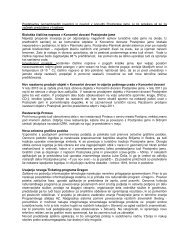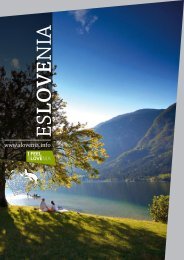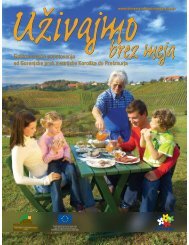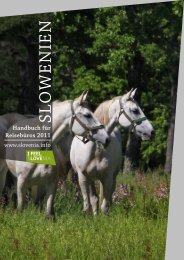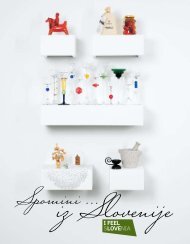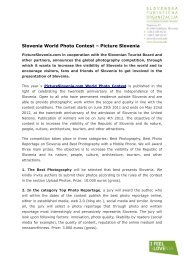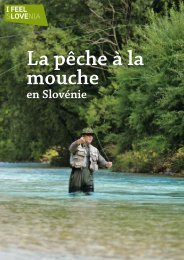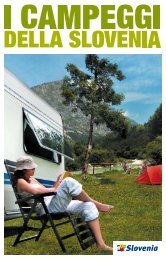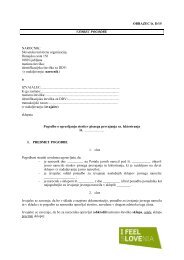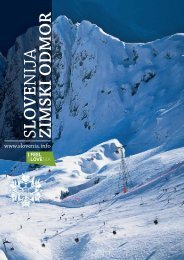Create successful ePaper yourself
Turn your PDF publications into a flip-book with our unique Google optimized e-Paper software.
Natural<br />
world<br />
Nature is our beautiful teacher. 'Look<br />
after me and I will make you happy'<br />
nature tells us every day.<br />
At Sečovlje Saltpans Regional<br />
Park people started to take salt at<br />
the beginning of the 9th century.<br />
Progress in salt-taking has not driven<br />
away over 200 animal and plant species<br />
nor destroyed other treasures<br />
of the saltpans ecosystem. Sečovlje<br />
saltpans are one of the most important<br />
areas of Slovenian natural and<br />
cultural heritage and the salt they<br />
produce is of the best quality. The<br />
salt-making museum was created in<br />
the disused part of the saltpants.<br />
Strunjan Natural Reserve is<br />
a part of the regional park and also<br />
includes saltpans. On the Strunjan hill<br />
you can see the church of the Ascension<br />
of Virgin Mary, the most famous<br />
Istrian place of pilgrimage. Above the<br />
church, on the edge of the flysch cliff,<br />
stands a big cross.<br />
Dragonja Nature Park was<br />
named after the disappearing river<br />
Dragonja. It is a part of Natura 2000<br />
network.<br />
Cape Madona is one of the most<br />
interesting places in Piran, with incredible<br />
underwater biodiversity.<br />
An extremely interesting sight is<br />
the Škocjanski zatok Nature<br />
Reserve, the biggest brackish<br />
wetland is Slovenia, a fascinating<br />
natural habitat of many endangered<br />
animal and plant species.<br />
Debeli rtič rounds off the Ankaran<br />
peninsula. It is a natural monument, a<br />
protected coastline area with the only<br />
salty meadow in the Mediterranean.<br />
Spodmol and Natural Bridge<br />
at Sočerga, an impressive cliff with<br />
three uniquely-shaped rock shelters,<br />
belong among the greatest natural<br />
sights.<br />
Visit the area of the Karst edge,<br />
the geological boundary where Karst<br />
limestone changes to Istrian flysch.<br />
Along the Karst edge we can see a<br />
series of fortifications and towers,<br />
silent witnesses to historical events,<br />
battles between the Venetians and<br />
the Hapsburgs.<br />
It is almost impossible to list all the<br />
fascinating attractions. Let this small<br />
fragment act as an invitation and stir<br />
your imagination.<br />
Cultural<br />
sights<br />
Buildings, stones, monumentsand<br />
famous people who gave their names<br />
to the streets, squares and embankments,<br />
are all a part of history.<br />
The entire city of Piran is a historical<br />
monument. Since the 13th<br />
century, the heart of the city has been<br />
the central Tartini Square, named<br />
after the famous violinist and composer<br />
Giuseppe Tartini. On the 300th<br />
anniversary of his birth, the square<br />
was renovated. Its new elliptic platform<br />
of white stone was designed by<br />
the famous architect Boris Podrecca.<br />
The white stone leads us further on to<br />
Tartini's house, where you can see<br />
the composer's room and his violin.<br />
Here is also the Town Hall, which<br />
has performed this function since the<br />
18th century. Not far from the square,<br />
we reach the Minorite monastery of<br />
St. Francis, dating back to the year<br />
1301, with a cross-shaped monastery<br />
arcade. The Venetian is the name<br />
of a red house at the edge of Tartini<br />
Square. An old legend says that the<br />
house was bought by a rich merchant<br />
as a present to his beloved. On the<br />
wall of the house we can still see the<br />
inscription 'Lasa pur dir', meaning 'Let<br />
them talk'. Walking across the 1st May<br />
Square we come to the centre of the<br />
old city of Piran, Punta. Above the city<br />
stands the magnificent Church of St.<br />
George, the patron saint of Piran.<br />
Its treasury holds a silver statue of St.<br />
George. The church is presently being<br />
restored. The surrounding City Wall<br />
with seven gates was built over many<br />
centuries, from the 7th to the beginning<br />
of the 16th century. The city also<br />
boasts a number of galleries, the<br />
most prominent being Forma Viva<br />
on the Seča peninsula. If you visit the<br />
six Piran museums you will learn a<br />
lot about the world of the sea, salt-taking,<br />
maritime lifestyle as well as see<br />
interesting ethnological and musical<br />
collections.<br />
And now to Izola. The Park of<br />
Pietro Coppo, a geographer,<br />
cartographer and explorer, who was<br />
born here, is the lively centre of the<br />
city and a green place of relaxation.<br />
In the Church of St. Maurus, the<br />
patron saint of Izola, there are many<br />
interesting religious objects. Walking<br />
to the San Simon seaside resort,<br />
we come across an archaeological<br />
site with artifacts from Roman times,<br />
a national cultural monument.<br />
Many historical buildings in Koper<br />
speak of the city's past. The majority<br />
of them can be found around Tito<br />
Square, former Platea Comunis,<br />
one of the most beautiful squares of<br />
the Venetian Republic. On the edge of<br />
the square you see the Praetorian<br />
Palace, a former headquarters of<br />
town officials, still performing the<br />
same function. Inside the palace<br />
there is also an exhibition area.<br />
Armeria and Foresteria are used<br />
as the head office of the University of<br />
Primorska and Faculty of Humanities.<br />
Loggia, a former town debate club,<br />
is today a pleasant coffeehouse with<br />
a view of the square and old buildings.<br />
Nearby stands the church of<br />
Mary's Ascension, a mixture of<br />
Gothic and Renaissance style with a<br />
bell tower offering a magnificent<br />
view of the city. Prešeren Square<br />
can be reached if we step through the<br />
Muda Gate. The jewel of the square<br />
is Da Ponte Fountain, a reproduction<br />
of Venetian Rialto. Carpaccio<br />
Square is near the sea, on its<br />
edge stand Carpaccio House and<br />
Taverna, which serves as a venue<br />
for numerous events. Belgramoni-<br />
Tacco Palace is the headquarters<br />
of the Regional Museum and one of<br />
the most beautiful baroque palaces<br />
in the city. Callegaria, the main street<br />
of the City, today called Čevljarska<br />
ulica (Shoemaker street) has always<br />
been the street of merchants and<br />
craftsmen.<br />
Slovenian<br />
Istria<br />
14



